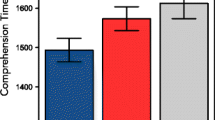Abstract
A previous experimental analog study by Sierra et al. International Journal of Psychology and Psychological Therapy, 16, 265–279 (2016) showed that including common physical properties of participants’ pain in the metaphor content improved its effect in promoting pain tolerance. Using a 2x2 factorial design, this study analyzed the effect of common physical properties in the context of multiple examples of functionally equivalent metaphors. Eighty-four participants responded to a measure of experiential avoidance. They were subsequently exposed to a cold-pressor task at pretest. Participants were then randomly assigned to four experimental protocols: (a) three functionally equivalent metaphors with common physical properties of participants’ pain, (b) three functionally equivalent metaphors without common physical properties, (c) a metaphor with common physical properties that was repeated three times, and (d) a metaphor without common physical properties that was repeated three times. Participants were then reexposed to the cold-pressor task (posttest). Bayesian data analyses showed that the presence of common physical properties was the only variable associated with an increase of the metaphor effect, and this was independent of the number of metaphors proposed. The update of evidence by means of a Bayes factor meta-analysis showed that data very strongly support the hypothesis of common physical properties being an effective component of metaphors. These results highlight the relevance of training therapists in designing metaphors with common physical properties of the clients’ discomfort.


Similar content being viewed by others
References
Bond, F. W., Hayes, S. C., Baer, R. A., Carpenter, K. M., Guenole, N., Orcutt, H. K.,. .. & Zettle, R. D. (2011). Preliminary psychometric properties of the acceptance and action questionnaire–II: A revised measure of psychological inflexibility and experiential avoidance. Behavior Therapy , 42, 676–688.
Brown, A. L., Kane, M. J., & Echols, C. H. (1986). Young children's mental models determine analogical transfer across problems with a common goal structure. Cognitive Development, 1, 103–121.
Catrambone, R., & Holyoak, K. J. (1989). Overcoming contextual limitations on problem-solving transfer. Journal of Experimental Psychology. Learning, Memory, and Cognition, 15, 1147–1156.
Chen, Z., & Daehler, M. W. (1989). Positive and negative transfer in analogical problem solving by 6-year-old children. Cognitive Development, 4, 327–368.
Eifert, G. H., & Forsyth, J. P. (2005). Acceptance & Commitment Therapy for anxiety disorders: A practitioner's treatment guide to using mindfulness, acceptance, and values-based behavior change strategies. Oakland, CA: New Harbinger.
Foody, M., Barnes-Holmes, Y., Barnes-Holmes, D., Törneke, N., Luciano, C., Stewart, I., & McEnteggart, C. (2014). RFT for clinical use: The example of metaphor. Journal of Contextual Behavioral Science, 3, 305–313.
Gelman, A., Carlin, J. B., Stern, H. S., Dunson, D. B., Vehtari, A., & Rubin, D. B. (2014). Bayesian data analysis (Vol. 2). Boca Raton, FL: CRC Press.
Gick, M., & Holyoak, K. J. (1983). Schema induction and analogical transfer. Cognitive Psychology, 15, 1–38.
Gil-Luciano, B., Ruiz, F. J., Valdivia-Salas, S., & Suárez-Falcón, J. C. (2016). Differential effect of framing behavior through deictic and hierarchical relations on tolerance experimental tasks. Psychological Record, 67, 1–9.
Gutiérrez, O., Luciano, C., Rodríguez, M., & Fink, B. C. (2004). Comparison between an acceptance based and a cognitive control based protocol for coping with pain. Behavior Therapy, 35, 768–783.
Guttman, I. (1973). Premium and protection of several procedures for dealing with outliers when sample sizes are moderate and large. Technometrics, 15, 385–404.
Hayes, S. C., Strosahl, K. D., & Wilson, K. G. (1999). Acceptance and commitment therapy: An experiential approach to behavior change. New York, NY: Guilford Press.
Hayes, S. C., Barnes-Holmes, D., & Roche, B. (2001). Relational frame theory: A post-Skinnerian account of human language and cognition. New York, NY: Plenum Press.
Hayes, S. C., Luoma, J., Bond, F. W., Masuda, A., & Lillis, J. (2006). Acceptance and commitment therapy: Model, processes, and outcomes. Behaviour Research and Therapy, 44, 1–25.
Hayes, S. C., Strosahl, K. D., & Wilson, K. G. (2012). Acceptance and commitment therapy: The process and practice of mindful change. New York, NY: Guilford Press.
JASP Team. (2017). JASP (version 0.8.4) [computer software]. Retrieved from https://jasp-stats.org/.
Jeffreys, H. (1961). Theory of probability (3rd ed.). Oxford, UK: Oxford University Press.
Keogh, E., Bond, F. W., Hanmer, R., & Tilston, J. (2005). Comparing acceptance- and control-based coping instructions on the cold-pressor pain experiences of healthy men and women. European Journal of Pain, 9, 591–598.
Kopp, R. (1995). Metaphor therapy: Using client-generated metaphors in psychotherapy. New York, NY: Brunner/Mazel.
Kotovsky, L., & Gentner, D. (1996). Comparison and categorization in the development of relational similarity. Child Development, 67, 2797–2822.
Lee, M. D. (2004). A Bayesian analysis of retention functions. Journal of Mathematical Psychology, 48, 310–321.
Lipkens, R. (1992). Analogical reasoning as arbitrarily applicable relational responding. University of Nevada, Reno: Unpublished doctoral dissertation.
Loewenstein, J., Thompson, L., & Gentner, D. (1999). Analogical encoding facilitates knowledge transfer in negotiation. Psychonomic Bulletin & Review, 6, 586–597.
Luciano, C., Valdivia-Salas, S., Cabello, F., & Hernández, M. (2009). Developing self-directed rules. In R. A. Rehfeldt & Y. Barnes-Holmes (Eds.), Derived relational responding. Applications for learners with autism and other developmental disabilities (pp. 335–352). New Harbinger: Oakland, CA.
Luciano, C., Valdivia-Salas, S., & Ruiz, F. J. (2012). The self as the context for rule-governed behavior. In L. McHugh & I. Stewart (Eds.), The self and perspective taking: Research and applications (pp. 143–160). Oakland, CA: Context Press.
McLoughlin, S., & Stewart, I. (2017). Empirical advances in studying relational networks. Journal of Contextual Behavioral Sciences, 6, 329–342.
McMullen, L. M. (2008). Putting it in context: Metaphor and psychotherapy. In R. W. Gibbs (Ed.), The Cambridge handbook of metaphor and thought (pp. 397–411). New York, NY: Cambridge University Press.
Mitchell, L. A., MacDonald, R. A., & Brodie, E. E. (2004). Temperature and the cold pressor test. The Journal of Pain, 5, 233–238.
Pokhrel, B. R., Malik, S. L., Ansari, A. H., Paudel, B. H., Sinha, R., & Sinha, M. (2013). Effect of sub-maximal exercise stress on cold-pressor pain: A gender based study. Kathmandu University Medical Journal, 41, 54–58.
Ross, B. H., & Kennedy, P. T. (1990). Generalizing from the use of earlier examples in problem solving. Journal of Experimental Psychology. Learning, Memory, and Cognition, 16, 42–55.
Rouder, J. N., & Morey, R. D. (2011). A Bayes factor meta-analysis of Bem’s ESP claim. Psychonomic Bulletin & Review, 18, 682–689.
Rouder, J. N., Morey, R. D., Verhagen, A. J., Swagman, A. R., & Wagenmakers, E.-J. (2017). Bayesian analysis of factorial designs. Psychological Methods, 22, 304–321.
Ruiz, F. J., & Luciano, C. (2011). Cross-domain analogies as relating derived relations among two separate relational networks. Journal of the Experimental Analysis of Behavior, 95, 369–385.
Ruiz, F. J., & Luciano, C. (2012). Relacionar relaciones como modelo analítico-funcional de la analogía y la metáfora [Relating relations as an analytical-functional model of analogy and metaphor]. Acta Comportamentalia, 20, 5–31.
Ruiz, F. J., & Luciano, C. (2015). Common physical properties among relational networks improve analogy aptness. Journal of the Experimental Analysis of Behavior, 103, 498–510.
Ruiz, F. J., & Perete, L. (2015). Application of a relational frame theory account of psychological flexibility in young children. Psicothema, 27, 114–119.
Ruiz, F. J., Langer, A. I., Luciano, C., Cangas, A. J., & Beltrán, I. (2013). Measuring experiential avoidance and psychological inflexibility: The Spanish translation of the acceptance and action questionnaire-II. Psicothema, 25, 123–129.
Ruiz, F. J., Suárez-Falcón, J. C., Cárdenas-Sierra, S., Durán, Y., Guerrero, K., & Riaño-Hernández, D. (2016). Psychometric properties of the acceptance and action questionnaire-II in Colombia. Psychological Record, 66, 429–437.
Sierra, M. A., Ruiz, F. J., Flórez, C. L., Riaño-Hernández, D., & Luciano, C. (2016). The role of common physical properties and augmental functions in metaphor effect. International Journal of Psychology and Psychological Therapy, 16, 265–279.
Stewart, I., & Barnes-Holmes, D. (2001). Understanding metaphor: A relational frame perspective. Behavior Analyst, 24, 191–199.
Stewart, I., & Barnes-Holmes, D. (2004). Relational frame theory and analogical reasoning: Empirical investigations. International Journal of Psychology and Psychological Therapy, 4, 241–262.
Stewart, I., Barnes-Holmes, D., Hayes, S. C., & Lipkens, R. (2001a). Relations among relations: Analogies, metaphors, and stories. In S. C. Hayes, D. Barnes-Holmes, & B. Roche (Eds.), Relational frame theory: A post-Skinnerian account of human language and cognition (pp. 73–86). New York, NY: Kluwer Academic/Plenum.
Stewart, I., Barnes-Holmes, D., Roche, B., & Smeets, P. M. (2001b). Generating derived relational networks via the abstraction of common physical properties: A possible model of analogical reasoning. Psychological Record, 51, 381–408.
Stewart, I., Barnes-Holmes, D., Roche, B., & Smeets, P. M. (2002). A functional-analytic model of analogy: A relational frame analysis. Journal of the Experimental Analysis of Behavior, 78, 375–396.
Stoddard, J., & Afari, L. (2014). Big book of ACT metaphors: A practitioner’s guide to experiential exercises and metaphors in Acceptance and Commitment Therapy. Oakland, CA: New Harbinger.
Tay, D. (2013). Metaphor in psychotherapy: A descriptive and prescriptive analysis. Amsterdam, The Netherlands: John Benjamins.
Törneke, N. (2010). Learning RFT. An introduction to relational frame theory and its clinical application. Oakland, CA: New Harbinger.
Törneke, N. (2017). Metaphor In Practice: A professionals’ guide to using the science of language in Psychotherapy Oakland, CA: New Harbinger.
Törneke, N., Luciano, C., Barnes-Holmes, Y., & Bond, F. W. (2016). RFT for clinical practice: Three core strategies in understanding and treating human suffering. In R. D. Zettle, S. C. Hayes, D. Barnes-Holmes, & T. Biglan (Eds.), The Wiley handbook of contextual behavioral science (pp. 254–272). Chichester, UK: John Wiley & Sons.
Villatte, M., Villatte, J. L., & Hayes, S. C. (2016). Mastering the clinical conversation: Language as intervention. New York, NY: Guilford Press.
Wagenmakers, E.-J., Wetzels, R., Borsboom, D., & van der Maas, H. L. J. (2011). Why psychologists must change the way they analyze their data: The case of psi. Journal of Personality and Social Psychology, 100, 426–432.
Wagenmakers, E.-J., Love, J., Marsman, M., Jamil, T., Ly, A., Verhagen, J., et al. (2018). Bayesian statistical inference for psychological science. Part II: Example applications with JASP. Psychonomic Bulletin & Review, 25, 48–76.
Zettle, R. D. (2007). ACT for depression: A clinician’s guide to using Acceptance and Commitment Therapy in treating depression. New York, NY: New Harbinger.
Author information
Authors and Affiliations
Corresponding author
Ethics declarations
Conflict of Interest
The authors declare that they have no conflict of interest.
Ethical Approval
All procedures performed in this study were in accordance with the ethical standards of the institutional and/or national research committee and with the 1964 Helsinki declaration and its later amendments or comparable ethical standards.
Informed Consent
Informed consent was obtained from all individual participants included in the study.
Rights and permissions
About this article
Cite this article
Criollo, A.B., Díaz-Muelle, S., Ruiz, F.J. et al. Common Physical Properties Improve Metaphor Effect Even in the Context of Multiple Examples. Psychol Rec 68, 513–523 (2018). https://doi.org/10.1007/s40732-018-0297-9
Published:
Issue Date:
DOI: https://doi.org/10.1007/s40732-018-0297-9




